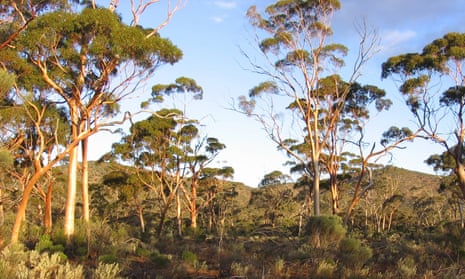Environmental recognition of the Great Western Woodlands, the largest remaining temperate woodlands in the world, will not be supported if it impinges on mining, the Western Australia mining minister, Bill Marmion, has said.
The woodlands cover 16m hectares (39m acres) from Kalgoorlie, 600km east of Perth, to Esperance and the Nullarbor Plain.
They’re home to 3,000 species of flowering plants – about 20% of all those identified in Australia – and 25% of all known eucalypt species.
But despite its ecological significance only about 12% is protected, with most falling on unallocated crown land.
At a business forum hosted by the local chamber of commerce and industry in Kalgoorlie on Monday, Marmion said: “The Great Western Woodlands is a vast area, a vast area and any sort of recognition which would put constraints on mining in the area would be absolutely devastating for Western Australia.
“Of course there is the danger that when you give something greater recognition, that recognition gets bigger and bigger and bigger. So I can’t see any government, of any persuasion, ever supporting that sort of approach.
“Admittedly I’m sure there are some green groups that would. Hopefully they’ll never get into government.”
According to the ABC Marmion, who was in Kalgoorlie before a regional cabinet meeting on Tuesday, offered the comments in response to a question about “green encroachment” on the mining town.
Peter Robertson, a campaigner for the Wilderness Society of WA, said Marmion’s comments were “disappointing, narrow-minded, but not surprising”.
Robertson added: “Ever since Bill Marmion was made mining minister he has shown himself to be single-mindedly, even narrow-mindedly, concerned with furthering the interests of the mining industry to the exclusion of all other interests and concerns.”
There are already dozens of mines within the footprint of the woodlands and it was possible for further environmental recognition to coexist with the mining industry, Robertson said. But some areas such as the Helena and Aurora Range, a banded limestone formation 200km east of Kalgoorlie, should be protected from destruction.
Marmion has asked the Environmental Protection Authority to reassess a proposal by Polaris Metals to dig two open-cut iron ore mines in the Helena and Aurora range, which the EPA in January 2015 declared “environmentally unacceptable”.
The EPA report notes it recommended the area be made into a class A reserve as far back as 2007, because it is a biodiversity hotspot and a “high priority for conservation”.
The Barnett government has developed a biodiversity and conservation strategy for the Great Western Woodlands, and allocated $3.8m to projects that met its “strategic priorities”, but none of those priorities include further formal protection.
In June 2014 at a regional cabinet meeting in Esperance, the WA government was briefed on a proposal to convert 500,000 hectares of unallocated crown land within the woodland into farmland.
That proposal is yet to be finalised, but the Wilderness Society has warned that clearing the area for farmland could release 40m tonnes of carbon dioxide into the atmosphere.
Robertson said because about 60% of the Great Western Woodland was classified as unallocated crown land, it was difficult to mount an argument for protection.
“We basically have the situation where, because it’s unallocated crown land, we’re saying the state does not value this, so developers and mining companies can come along and think the area has no value,” he said.
“It’s the lowest level of protection, but we are dealing with what is just about the most ecologically important area of the state.”

Comments (…)
Sign in or create your Guardian account to join the discussion